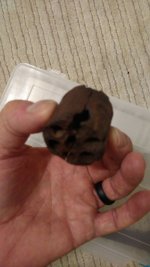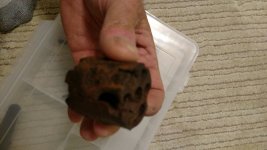azdave
Full Member
I've been sorting through finds, and decided to separate the various gun parts I've found in remote areas of AZ into one container instead of by location.
This particular piece (or pieces) I found about a year ago at a mine that was located in the early 1880's, and worked only a few years... it's definitely remote and long forgotten.
It is the cylinder to a cap-and-ball revolver, 36 caliber, that was "blown" in half. I suspect it was what is called a "chain-fire" incident, whereas the shooter does a messy job when loading the chambers, and when the trigger is pulled it ignites multiple chambers in the cylinder, causing a "catastrophic failure." Or a severe overcharge of one chamber that ignites an adjacent chamber.
Although the crappy pics don't show it well, it is obvious that one chamber blew out the cylinder wall, and the chamber next to it ignited, with the ball slamming into the frame and severely "denting" the cylinder face. 3 nipples were blown out as well.
How would you like to have that happen in your hand?? The pieces were about 20 yards apart... one about 6 inches deep, the other on the surface. No other parts of the pistol were ever found... and I've hit it hard expecting some to come up. This area was littered with WRA 44wcf (44-40) casings and several FA 45-70 casings with mid-80's dates, so it was definitely their little "shooting spot."
Been meaning to share this.... it sure would have been a bad day for someone at this spot almost a century and a half ago.





This particular piece (or pieces) I found about a year ago at a mine that was located in the early 1880's, and worked only a few years... it's definitely remote and long forgotten.
It is the cylinder to a cap-and-ball revolver, 36 caliber, that was "blown" in half. I suspect it was what is called a "chain-fire" incident, whereas the shooter does a messy job when loading the chambers, and when the trigger is pulled it ignites multiple chambers in the cylinder, causing a "catastrophic failure." Or a severe overcharge of one chamber that ignites an adjacent chamber.
Although the crappy pics don't show it well, it is obvious that one chamber blew out the cylinder wall, and the chamber next to it ignited, with the ball slamming into the frame and severely "denting" the cylinder face. 3 nipples were blown out as well.
How would you like to have that happen in your hand?? The pieces were about 20 yards apart... one about 6 inches deep, the other on the surface. No other parts of the pistol were ever found... and I've hit it hard expecting some to come up. This area was littered with WRA 44wcf (44-40) casings and several FA 45-70 casings with mid-80's dates, so it was definitely their little "shooting spot."
Been meaning to share this.... it sure would have been a bad day for someone at this spot almost a century and a half ago.





Last edited:
Upvote
18








